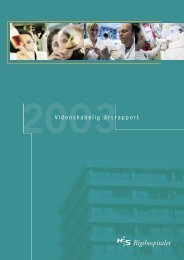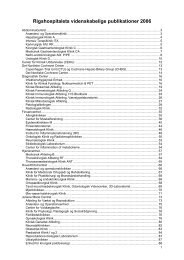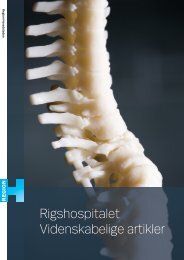View - CTU
View - CTU
View - CTU
Create successful ePaper yourself
Turn your PDF publications into a flip-book with our unique Google optimized e-Paper software.
, caries in adults 291<br />
I yr. With an anticipated<br />
.I was planned to include<br />
: patients referred to two<br />
iols at the University of<br />
rsity) and four Swedish<br />
Stockholm; Faculty of<br />
iblic Dental Service; and<br />
e) participated .. Inclus!on<br />
a primary canes . les10n<br />
r more of the dentm; and<br />
iodense zone between the<br />
2). In patients who re-<br />
,0ked and confirmed by<br />
ressed air (pretreatment<br />
·olonged unbearable pain<br />
,; no response to cold ~nd<br />
nt loss > 5 mm; apical<br />
;temic disease preventing<br />
onsent. Written informed<br />
~ patients participating in<br />
identifying eligible caries<br />
iresen ting different lesion<br />
cedure potentially eligible<br />
' chart (Fig. 2). The allo<br />
'vation vs. direct complete<br />
nerated, stratified for pain<br />
1 yr), and centre in. blocks<br />
own to the investigators.<br />
ied through central tele<br />
~n Trial Unit). One tooth<br />
d patient. Patients were<br />
ent, and all were seen in at<br />
ed to pulp exposure the<br />
for the pulp capping trial<br />
1e patient had participated<br />
in the section above; the<br />
· the excavation of caries<br />
ion) (n =5)<br />
" and final number of cases<br />
292 Bjomdal el al.<br />
Excluded<br />
Included<br />
Included<br />
Included<br />
Excluded<br />
Fig. 2. The scoring chart used for the selection of cases is<br />
shown. Included teelh had caries lesions radiographically extending<br />
75% or more into the dentin and walled off from the<br />
pulp by a well visible radiodense zone. A tooth was excluded if<br />
the caries lesion was either loo small (as illustrated in the lop)<br />
or loo deep (bollom).<br />
(mild pain could be present); and written informed consent<br />
had been given to take part. Exclusion criteria were: prolonged<br />
unacceptable pain or pain disturbing the night sleep;<br />
and pus draining from the exposed pulp. Eligible P'.Itients<br />
were centrally randomized to either direct pulp cappmg vs.<br />
partial pulpotomy using a similar randomization procedure<br />
as the one described for the excavation trial but only<br />
stratifying for pain (yes or no) (Fig. 1). The excavation trial<br />
u.no: 03-004/03) and the pulp capping trial u.no: 13-002/04)<br />
were approved by the joint Copenhagen and Frederiksberg<br />
ethics committees in Denmark and by the ethics<br />
con;mittee at the Sahlgrenska Academv. University of<br />
Gothenburg. Sweden (j.~o: 083-05), and ·was registered in<br />
the Danish Data Protection Agency (j.no: 2008-42-20329)<br />
and at http://www.ClinicalTrials.gov (NCT00187850 and<br />
NCTOOl87837). The trials were investigator initiated and<br />
investigator controlled.<br />
Clinical procedures<br />
The penetration depth of the lesion was assessed in bitewing<br />
radiographs (Insight JP22 film: Kodak, Stuttgart, Germany)<br />
Fig. 3. A. B: Preoperative radiographs of a permanent upper<br />
right second premolar (stepwise excavation). Al the I-yr radiographical<br />
follow-up (C) the tooth was classified as a success<br />
(pulp vitality without apical radiolucency). D, E: Preoperative<br />
radiographs of a permanent lower right first molar (direct complele<br />
excavation). Al the I-yr follow-up (F) the tooth was<br />
classified as a failure (no pulp vitality wilh apical radiolucency).<br />
(Fig. 3A,D). The penetration depth was expressed as the<br />
ratio between the maximum depth of the carious dentin<br />
(AB, Fig. 4) and the total dentin thickness (AC, Fig. 4),<br />
measured using computer software (PPX VIEW PRO version<br />
PRO 1.11.18; DeltaPix, Mtdov, Denmark). The point A<br />
represented half the distance of the spread of the radiolucent<br />
carious dentin along the enamel-








